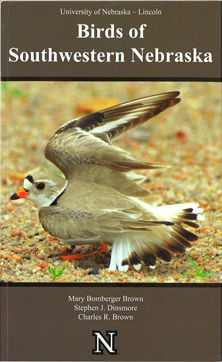
Birding enthusiasts have something new to crow about: "Birds of Southwestern Nebraska" has landed. The book is the latest annotated guide to bird species found in and around the Lake McConaughy region, published by the University of Nebraska-Lincoln’s Conservation and Survey Division within the School of Natural Resources.
Serious birders and casual enthusiasts alike will find plenty to sink their teeth into. The book is the combined result of decades of observational data taken by Mary Bomberger Brown, UNL's School of Natural Resources, Stephen J. Dinsmore, Iowa State University, and Charles R. Brown, University of Tulsa, with contributions from dozens of other researchers.
Inspired by "Birds of the Cedar Point Biological Station," written by Mary Bomberger Brown and Charles Brown in 2001, "Birds of Southwestern Nebraska" features more species, year-round occurrence observations, and full-color photos courtesy of renowned ornithologist and UNL professor Paul A. Johnsgard.
"Anybody that’s interested in Nebraska’s natural history, certainly anyone who’s interested in birds of Nebraska or the Great Plains would find this book useful," Charles Brown said.
The Lake McConaughy State Recreation Area, located in Keith and Garden County, Neb., eight miles northeast of the city of Ogallala, is home to more than 360 bird species, more than 80 percent of all species found across Nebraska through 2011.
"It's the most diverse birding spot of similar size anywhere in the Great Plains," Dinsmore said.
This impressive diversity stems from a confluence of different ecosystems, including the Sandhills, cottonwood forests, the North and South Platte Rivers, and Lake McConaughy itself. A variety of aquatic birds and those from northern and southern regions converge here, resulting in a unique meeting place for a host of divergent species, including Baltimore and Bullocks orioles, Rose-breasted and Black-headed grosbeaks, and Indigo and Lazuli buntings.
The authors' goal in creating this guide was to both educate prospective birders and promote Nebraska's own biodiversity.
"We want people to look out their windows and appreciate what’s out there," said Bomberger Brown. "You don't have to go to Costa Rica to see huge diversity. It's right here in Nebraska."
"Birds of Southwestern Nebraska" is available now for $19.95 in the Nebraska Maps and More Store, located in the first floor lobby of Hardin Hall on UNL East Campus. The store is open from 8 a.m. to 5 p.m. Monday through Friday, and can be found online at http://nebraskamaps.unl.edu/. The book is also available on Amazon and at local and regional booksellers.
- Adam Yarina, School of Natural Resources